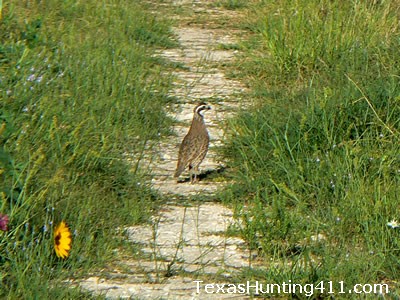Ask any “old timer” and they will tell you that Texas quail hunting was fairly good 50 or 60 years ago all across the state. That’s far from the case today. But it has been the loss of quail habitat, not quail hunting, that has hit quail numbers the hardest. They need good habitat—the right kinds of plants—to survive. Texas Parks and Wildlife Department (TPWD) hopes to give habitat and their numbers a boost.
TPWD is taking a “boots on the ground” approach to bobwhite quail management in Texas as part of a strategic action plan that involves hunters, landowners and science. The plan focuses on habitat management and does not include changes in harvest regulations. Because regulations will not compensate for losses in quail habitat, the Texas Parks and Wildlife Department is making no changes to the quail hunting season for 2012-13. The season will open Oct. 27 and close Feb. 24, 2013 with a daily bag limit of 15, possession limit of 45.

“Hunting is a tool to regulate harvest of quail, but not a tool that could impact quail recovery at a landscape level,” said Robert Perez, TPWD Upland Game Bird Program Leader. “Hunting didn’t create this problem.” The long term trend in declining bobwhite populations have also impacted more than two dozen other grassland bird species that are not hunted. Biologists recognize the primary cause for these declines is loss of usable habitat. Habitat management focused on restoration will be the prescribed cure for Texas’ quail population.
During the next four years, TPWD will implement and monitor quail management strategies at three “focus area” sites in different parts of the state. The model for the project was developed in cooperation with the National Bobwhite Conservation Initiative and the Oaks and Prairies Joint Venture and is a component of TPWD Wildlife Division’s Upland Game Bird Strategic Plan.
“These efforts will allow us to test the hypotheses that given enough usable habitat, we can sustain viable populations of quail over boom and bust cycles,” Perez said. “Historically, our wildlife biologists have worked with landowners to develop management plans for quail, but we’ve never attempted to quantify those efforts at a larger scale.”
During the upcoming hunting season, Texas Parks and Wildlife Department biologists will also be looking to hunters to help collect and report data that can be used to more accurately monitor quail hunting and harvest. Currently, TPWD relies on information gathered through its annual Small Game Harvest Survey of hunters to determine bobwhite quail harvest, which does not include daily harvest by county.
By issuing a harvest scorecard to a random group of quail hunters prior to the season, and using methodology similar to that developed for tracking migratory game bird harvest, TPWD hopes to get a more accurate accounting of wild bobwhite harvest. The future of Texas quail hunting is hinged to good habitat for these upland game birds. The loss of native clump grasses have hurt quail numbers the most, but improved pastures, fire ants and increased development have not helped either.